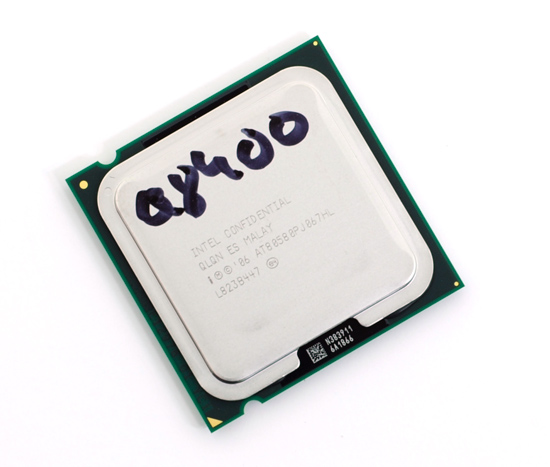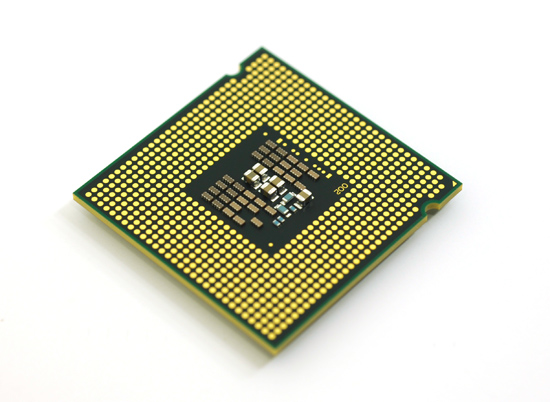The Core 2 Quad Q8400: Intel's $183 Phenom II 940 Competitor
by Anand Lal Shimpi on May 7, 2009 12:00 AM EST- Posted in
- CPUs
I’ve been writing about the “new” Intel for nearly three years now. It’s been so long that I almost forgot what the old Intel was like. It’s not that the old Intel wasn’t competitive performance-wise, it’s that the old Intel wasn’t pleasant to work with. The old Intel was the one that always thought the Pentium 4 was the fastest thing on the planet, even when it wasn’t. The old Intel wasn’t forthcoming with information and acted like it worked in a world where it had no competition. The old Intel wasn’t a very good Intel.
The new one is nothing like that. We get open sharing of information, real discussion about AMD’s strengths and weaknesses and it also helps that we also get the world’s fastest microprocessors with it.
We’ve seen that the new Intel can stand the test of time, at least over the past three years. But can the new Intel last when it’s not always winning reviews? Sure, Intel’s Core i7 remains untouched but what about at cheaper price points? Last month we found out that Intel is quite competitive at the $70 with its Pentium E5300. But between the $70 E5300 and the $280 Core i7-920 there are a few price points where AMD is recommendable.
The question then becomes how does the new Intel deal when it isn’t the fastest on the market?
Surprisingly well it turns out.
This is the Core 2 Quad Q8400:

It’s a quad-core chip running at 2.66GHz with a 2MB L2 per pair of cores (4MB total). It’s like two Pentium Dual Core processors on a single package.
These chips actually have a 6MB L2 but with 2MB disabled either because they have irrecoverable defects in the cache or simply to hit the right price point. In other words, the Q8400 is literally a Q9400 but with 2MB of its L2 disabled.

The Q8400 is Intel’s most recent response to the Phenom II X4 940. Initially AMD priced the 940 similarly to the Q9400. Then, Intel cut prices so that the 940 had to compete with the much faster Q9550. AMD responded, with a price cut that put the 940 on par with the Q9400 again.
Once AMD began shipping Socket-AM3 Phenom IIs, it dropped the prices on its Socket-AM2+ parts once more. This wasn’t so much a price cut but rather a gradual phasing out of the AM2+ CPUs, eventually I expect an AM3-only market since those chips can also work in AM2+ boards.
Rather than take the bait and drop the Q9400 prices once more, Intel instead responded with the introduction of a similarly priced Q8400 at $183.
AMD’s Phenom II X4 940 was generally the same speed if not faster than Intel’s Core 2 Quad Q9400. With less cache, the Q8400 shouldn’t perform any better than the Q9400, so the question is - does it perform any worse?
Then there’s power consumption to worry about and overclocking, but we’ll get to those in due time. Let’s just say that the situation is far more complex than it seemed at first sight.










60 Comments
View All Comments
eXistenZ - Thursday, May 7, 2009 - link
Obviously, AMD is no good in Far Cry 2 game. K8, K10, K10.5, al these architectures were always slower than intel's competitors. And it is really crappy game, so i don't see any reason why are you testing right on this one. I think, more fair testing is with Crysis or CPU-eaters = RTS...Goty - Thursday, May 7, 2009 - link
Anand seems to be buying into all the FUD about AMD lately. Sure, AMD's not doing so hot right now, but they're not in much worse a position than they were in the middle of the P4 era (probably about the same position, all told).Anand Lal Shimpi - Friday, May 8, 2009 - link
I'm not sure I would call it FUD. AMD lost $2.36B before taxes in the last four quarters combined. Their chief competitor made $6.13B. Now Intel has always made more than AMD, but the issue now is that AMD is losing a considerable amount every quarter. That can only continue for so long.What I'm more worried about is the impact this is having on the next-generation cores that AMD is developing. While engineering budgets are the last things to go, if you're losing a few hundred million a quarter everyone from marketing to engineering gets hurt.
Ignoring the problem isn't going to make it go away, I felt that it would be important to at least bring some of this stuff to the table so we can at least be thinking about it.
Take care,
Anand
microAmp - Thursday, May 7, 2009 - link
Actually, it's worse, they are running out of cash.ssj4Gogeta - Thursday, May 7, 2009 - link
"It's the beauty of Moore's Law: with fewer transistors crammed into a much smaller area, we're able to see the same performance."Shouldn't it be "MORE transistors crammed into a much smaller area"?
:)
hooflung - Thursday, May 7, 2009 - link
I am another that buys based on the ability of Virtualization via virt functionality. I got a P2 940 because I wanted the ability to have 4 cores to split up to VM's running Hyper-V, Xen and KVM. I just can't do that on new intel chips that fall in the price range right now.My C2D is still rocking a venerable 1ghz OC on a e4300 and P35 chipset. For me to install an OS to do development as the top level is just wasting wattages at my home.
snakeoil - Thursday, May 7, 2009 - link
''Phenom II Earns a Financially Troubled AMD Less per Chip than Core 2 Quad''well you are saying that amd make less money because phenom 2 has a little more area,but in your happy calculations you forgot that bad quad core dies are used to make tricores and soon dual cores phenoms.
harvesting.
what are you doing little annand
crimson117 - Thursday, May 7, 2009 - link
One wafer costs a fixed amount to make; let's say $200.Let's say AMD can get 10 CPUs made from each wafer, while intel can get 20 smaller CPUs from each wafer. They each sell their chips for $180.
AMD puts $200/10 = $20 worth of wafer into each $180 CPU.
Intel only has to put in $200/20 = $10 worth of wafer into each $180 CPU.
So assuming all other things are equal, Intel makes $5 more on each CPU sale than AMD.
crimson117 - Thursday, May 7, 2009 - link
*clicks Edit button*So assuming all other things are equal, Intel makes $10 more on each CPU sale than AMD.
mkruer - Thursday, May 7, 2009 - link
You are also forgetting that AMD and Intel use two different lithphogathy technologies to AMD uses submersion and Intel uses double pattering. The Submersion takes slightly longer then a single pattering, and yeild fewer defects. This meas that AMD should be able to preduce a high volume of chips per platter then Intel. Adding to the confusion, is that neiter intel nor AMD releases what there yeilds are and as such, too comepare based upon die size alone is folly. People can crunch the numbers anyway they want, but in the end it should be a, for more or less, wash.